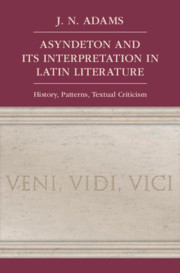Book contents
- Asyndeton and its Interpretation in Latin Literature
- Frontispiece
- Asyndeton and its Interpretation in Latin Literature
- Copyright page
- Contents
- Preface
- Acknowledgements
- Abbreviations
- Part 1 Introduction
- Part 2 ‘Grammatical’ Types
- Part 3 Semantic Types
- Part 4 Structures
- Chapter XVI Rule of Ascending Length (?)
- Chapter XVII Correlative Distribution
- Chapter XVIII End-Of-List Coordination and ‘Weak’ Asyndeton Bimembre
- Chapter XIX Accumulations of Asyndeta: a Few Patterns
- Chapter XX Discontinuous Asyndeton and Conjunct Hyperbaton
- Chapter XXI Asyndetic Pairs Dependent on a Single Preposition
- Part 5 Genres And Texts
- Part 6 Conclusions
- Bibliography
- Subject Index
- Index Mainly of Selected Pairs and Longer Sequences
- Selective Index Locorum
Chapter XVIII - End-Of-List Coordination and ‘Weak’ Asyndeton Bimembre
from Part 4 - Structures
Published online by Cambridge University Press: 13 May 2021
- Asyndeton and its Interpretation in Latin Literature
- Frontispiece
- Asyndeton and its Interpretation in Latin Literature
- Copyright page
- Contents
- Preface
- Acknowledgements
- Abbreviations
- Part 1 Introduction
- Part 2 ‘Grammatical’ Types
- Part 3 Semantic Types
- Part 4 Structures
- Chapter XVI Rule of Ascending Length (?)
- Chapter XVII Correlative Distribution
- Chapter XVIII End-Of-List Coordination and ‘Weak’ Asyndeton Bimembre
- Chapter XIX Accumulations of Asyndeta: a Few Patterns
- Chapter XX Discontinuous Asyndeton and Conjunct Hyperbaton
- Chapter XXI Asyndetic Pairs Dependent on a Single Preposition
- Part 5 Genres And Texts
- Part 6 Conclusions
- Bibliography
- Subject Index
- Index Mainly of Selected Pairs and Longer Sequences
- Selective Index Locorum
Summary
In English (for example) when three or more terms are in a coordinated sequence the normal structure is ‘AB and C’, with what is sometimes called ‘end-of-list’ coordination (see e.g. Haspelmath 2004: 572, index s.v. ‘end-of-list’): e.g. bacon, lettuce and tomatoes; Friends, Romans and countrymen. Latin had, up to a point, the same structure (in several forms because of the number of coordinators in the language), but how significant was it, and is it straightforward to interpret? For et and atque used thus (and associated textual problems) see Pinkster (1969). For -que see Adams (2016: 62–4, with some bibliography), with full details for Cato Agr. Pinkster (1969: 266), speaking of the different Latin coordinators found in this structure, says: ‘Que seems to have been most normal in “Classical” Latin, followed by zero, et, atque respectively’. This follows the generalisation: ‘in Latin A B & C is a normal pattern, occurring beside A B C and A B Cque’. According to Dyck (2010: 101) on Cic. S. Rosc.31, citing Pinkster, ‘xyzque appears to be the commonest way of organising three items in Latin’. That is not so. Torrego indeed states (2009: 472) that ‘the marked “A, B, & C” pattern’ ‘is not encountered often in Pre-Classical and Classical Latin, yet it becomes the standard pattern in Romance’, and his examples show that his formulation ‘A, B & C’ was intended to embrace all the Latin coordinators. In fact what Pinkster calls ‘zero’, that is asyndeton throughout (ABCD etc.), is much more common than the use of -que, and also common are what I would call sequences with multiple coordinations, that is with coordinators used within the list, not least to indicate internal unities. I will illustrate this pattern in section 3.
- Type
- Chapter
- Information
- Asyndeton and its Interpretation in Latin LiteratureHistory, Patterns, Textual Criticism, pp. 192 - 210Publisher: Cambridge University PressPrint publication year: 2021



